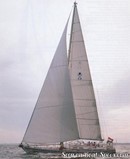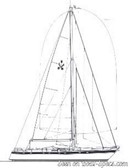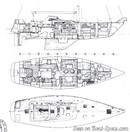Contest 58
Sailboat specifications
The Contest 58 is a 58’ (17.69m) cruising sailboat designed by Douglas Peterson (United States) and Dick Zaal Yacht Design (Netherlands). She was built between 1992 and 1993 by Conyplex (Netherlands).
Contest 58's main features
- Model
- Contest 58
- Hull type
- Monohull
- Category
- Offshore cruising sailboat
- Sailboat builder
- Sailboat designer
- Sailboat range
- Country
- Netherlands
- Construction
- GRP (glass reinforced polyester):
- Hull: Single skin fiberglass polyester
- Deck: Sandwich balsa fiberglass polyester - First built hull
- 1992
- Last built hull
- 1993
- Appendages
- Keel : fin without bulb
- Helm
- Single helm wheel
- Rudder
- Single rudder on skeg
- Unsinkable
- No
- Trailerable
- No
- Standard public price ex. VAT (indicative only)
- N/A €
Contest 58's main dimensions
- Overall length
- 58’17.69 m
- Hull length
- 58’17.69 m
- Waterline length
- 48’ 8”14.85 m
- Beam (width)
- 16’ 5”5 m
- Draft
- 7’ 6”2.3 m
- Light displacement (MLC)
- 70548 lb32000 kg
- Ballast weight
- 28660 lb13000 kg
- Ballast type
- Cast iron
Contest 58's rig and sails
- Upwind sail area
- 2186 ft²203.06 m²
- Downwind sail area
- 4048 ft²376.06 m²
- Mainsail area
- 894 ft²83.06 m²
- Genoa area
- 1292 ft²120 m²
- Symmetric spinnaker area
- 3154 ft²293 m²
- Rigging type
- Sloop Marconi masthead
- Mast configuration
- Deck stepped mast
- Rotating spars
- No
- Number of levels of spreaders
- 2
- Spreaders angle
- 0 °
- Spars construction
- Aluminum spars
- Standing rigging
- 1x19 strand wire continuous
Contest 58's performances
- Upwind sail area to displacementiThe ratio sail area to displacement is obtained by dividing the sail area by the boat's displaced volume to the power two-thirds.
The ratio sail area to displacement can be used to compare the relative sail plan of different sailboats no matter what their size.
Upwind: under 18 the ratio indicates a cruise oriented sailboat with limited performances especially in light wind, while over 25 it indicates a fast sailboat. - 217 ft²/T20.15 m²/T
- Downwind sail area to displacementiThe ratio sail area to displacement is obtained by dividing the sail area by the boat's displaced volume to the power two-thirds.
The ratio sail area to displacement can be used to compare the relative sail plan of different sailboats no matter what their size. - 402 ft²/T37.31 m²/T
- Displacement-length ratio (DLR)iThe Displacement Length Ratio (DLR) is a figure that points out the boat's weight compared to its waterline length. The DLR is obtained by dividing the boat's displacement in tons by the cube of one one-hundredth of the waterline length (in feet).
The DLR can be used to compare the relative mass of different sailboats no matter what their length:
a DLR less than 180 is indicative of a really light sailboat (race boat made for planning), while a DLR greater than 300 is indicative of a heavy cruising sailboat. - 277
- Ballast ratioiThe Ballast ratio is an indicator of stability; it is obtained by dividing the boat's displacement by the mass of the ballast. Since the stability depends also of the hull shapes and the position of the center of gravity, only the boats with similar ballast arrangements and hull shapes should be compared.
The higher the ballast ratio is, the greater is the stability. - 41 %
- Critical hull speediAs a ship moves in the water, it creates standing waves that oppose its movement. This effect increases dramatically the resistance when the boat reaches a speed-length ratio (speed-length ratio is the ratio between the speed in knots and the square root of the waterline length in feet) of about 1.2 (corresponding to a Froude Number of 0.35) . This very sharp rise in resistance, between speed-length ratio of 1.2 to 1.5, is insurmountable for heavy sailboats and so becomes an apparent barrier. This leads to the concept of "hull speed".
The hull speed is obtained by multiplying the square root of the waterline length (in feet) by 1.34. - 9.35 knots
Contest 58's auxiliary engine
- Engine(s)
- 1 inboard engine
- Fuel type
- Diesel
Contest 58's accommodations and layout
- Cockpit
- Center cockpit
- Cabin(s) (min./max.)
- 3 / 4
- Berth(s) (min./max.)
- 6 / 10
- Head(s) (min./max.)
- 3 / 4
Similar sailboats that may interest you:
Sailboats
First built hull
Hull length
1997
50’ 7”15.42 m
1988
52’ 6”16 m
2005
53’ 10”16.4 m
2012
54’ 8”16.68 m
2012
54’ 11”16.72 m
1997
61’ 11”18.88 m
2010
63’ 1”19.22 m
2010
57’ 6”17.53 m
1986
56’ 4”17.15 m
2000
52’ 6”16 m
2017
50’ 11”15.51 m
1985
49’ 11”15.22 m
2010
56’ 6”17.23 m
2018
57’ 2”17.44 m
2019
59’ 1”18 m


